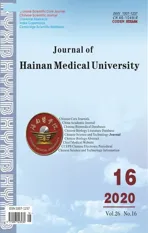Mechanism of Ganlu Xiaodu MicroPill against COVID-19 based on network pharmacology and molecular docking method
2020-10-10YuHuiKuangXiaoQiChenQingZhaoJiaQiLiangKangXieXinJuChen
Yu-Hui Kuang, Xiao-Qi Chen, Qing Zhao, Jia-Qi Liang, Kang Xie, Xin-Ju Chen✉
1. The first affiliated Hospital of Henan University of traditional Chinese Medicine ZhengZhou 450000
2. Beijing Shitan Hospital of Capital Medical University BeiJing 100089
3. Research Institute of traditional Chinese Medicine, Guangdong Pharmaceutical University GuangZhou 510006
Keywords:
ABSTRACT Objective: To analyze the potential active components and molecular mechanism of Ganlu Xiaodu MicroPill in the treatment of COVID-19 by network pharmacology and molecular docking. Methods: the active chemical constituents and action targets of Ganlu Xiaodu MicroPill were searched by TCMSP and BATMAN-TCM platform, and the key targets were matched with the COVID-19 targets searched by CTD database. The core targets were selected and analyzed by GO and KEGG enrichment analysis by R software to predict the action mechanism of traditional Chinese medicine compound. The key component sets were docked with 3CLpro and ACE2. Results: 138 active components and 53 key targets were obtained. There are 1298 items in GO biological process, 59 items in cell composition, 62 items in molecular function, and 120 items enriched in KEGG pathway. Results: molecular docking showed that the affinity of 20 chemical components such as quercetin, luteolin and kaempferol with ACE2 and 3CLpro was higher than that of ribavirin and chloroquine. Conclusion: Ganlu Xiaodu MicroPill may regulate and interfere with SARS-CoV-2 infection through antivirus, inhibition of inflammatory factors and regulation of immunity, which fully reflects the therapeutic advantages of multi-components, multi-targets and multi-pathways of traditional Chinese medicine.
1. Introduction
Since December 2019, an unexplained pneumonia epidemic has occurred in Wuhan, Hubei Province, and has now been confirmed as an acute respiratory infection caused by a new coronavirus infection. On February 11, 2020 [1], the World Health Organization named the new coronavirus-infected pneumonia "COVID-19", and the International Committee of Viral Taxonomy also officially named the new coronavirus "SARS-CoV-2". According to statistics from the World Health Organization [2], as of 18:00 on March 29, 2020, 82,230 cases have been diagnosed in China; 5,754,444 cases have been diagnosed in the world, and the United States, Italy and other countries are more serious. Our country stipulates its [3] as a category B infectious disease, and adopts the prevention and control measures of category A infectious disease, and has achieved remarkable results. At present, the epidemic situation in my country has been effectively alleviated, while the epidemic situation abroad is on the rise.
Since SARS-CoV-2 is a newly discovered virus, as of now, no specific drugs and vaccines against new coronavirus have been developed. However, Traditional Chinese Medicine [4] has played an important role in responding to various diseases for thousands of years, and has accumulated rich experience from it. It has been evaluated by the World Health Organization as a “safe and effective way”. During the fight against SARS in 2003 [5], Chinese medicine also played an important role. During this epidemic, the National Health Commission repeatedly includedTraditional Chinese Medicine treatment in the "New Coronavirus Infected Pneumonia Diagnosis and Treatment Program", strengthened the construction of the COVID-19 model of integrated Chinese and Western medicine diagnosis and treatment, and achieved tremendous results. With good control, the advantages of integrated Chinese and Western medicine treatment once again appear. Foreign medical scholars also pay more and more attention to the role of traditional Chinese medicine in the prevention and treatment of acute infectious diseases, strengthen exchanges with my country and learn from my country's experience in combating new coronary pneumonia. In this battlefield against the epidemic, traditional Chinese medicine has high hopes from China and the world.
Ganlu Xiaodu MicroPill (GXM), as a prescription for the treatment of plague, played an active role in this outbreak. This side was created by Qing, Ye Tianshi, and it was first published in the case of "Continued Famous Doctors" by Qing, Wei Zhixiu. Ye Tianshi said in "The Secret of Medical Efficacy: Volume One" [6]: " When poisonous and violent, Bing Sitian, Guihou too wet and gasification operation, and the acquired sun will be cold and humid... The chest is full... The wet evil is still breathing, disinfecting Ganlu Xiaodu MicroPill with nectar." Wang Mengying benefited from "The Warm and Warp" [7]: "This is also the master of the treatment of epidemics of dampness and temperature". Xue Shengbai, who was also a sick person in the Qing Dynasty, also affirmed the role of Ganlu Xiaodu MicroPill.
At present, modern studies have found that [8-9] Spikeprotein (S protein) on the coat of coronavirus is a key protein that recognizes host cell receptors during viral infection and is associated with angiotensin converting enzyme 2 (ACE2) Combine to infect cells. ACE2 is a transmembrane glycoprotein, which is expressed in many tissues and organs such as human nose and mouth mucosa, lung, heart, kidney and digestive system [10], indicating that all tissues expressing ACE2 may be SARS- The battlefield between CoV-2 and immune cells. 3CL hydrolase (Mpro) is the main protease of coronavirus and plays an important role in the process of viral replication. SARS-CoV-2 uses ACE2 as a receptor [11], which eventually leads to multiple organ failure and life-threatening. Therefore, ACE2 and 3CLMpro were selected as molecular docking ligands. At the same time, the recommended anti-COVID-19 therapeutic drugs chloroquine and ribavirin were compared in the trial fifth version issued by the National Health Commission [12].
Network pharmacology and molecular docking integrate a variety of disciplines, which can comprehensively analyze the relationship between drugs-diseases-genes-targets, and reveal the mechanism of action of drugs from a holistic perspective, which is consistent with the overall view of traditional Chinese medicine. Those who are conducive to traditional Chinese medicine should use modern technology [13] to explore the mechanism of traditional Chinese medicine treatment of diseases under the premise of adhering to the theory of traditional Chinese medicine, and promote the modernization and internationalization of traditional Chinese medicine. In order to further study the role of GXM and the molecular mechanism of COVID-19, this paper provides a further scientific basis for the development and clinical treatment of GXM anti-new coronavirus drugs through network pharmacology and molecular docking technology.
2. Materials and methods
2.1 Screening of GXM active ingredients and related targets
GXM is composed of White cardamom、Iris calamus、Patchouli, YinChen, Mutong, Talc、Scutellaria baicalensis、Forsythia、Mint、 Sichuan Fritillaria、Shot dry11 flavors of Chinese medicine. Respectively search the active chemical components and their functions of these 11 Chinese herbal medicines in TCMSP (http://tcmspw.com/tcmsp.php) and BATMAN-TCM (http://bionet.ncpsb.org/batman-tcm/) databases Protein target. In the TCMSP database, according to the ADME principle, two screening conditions are set: oral availability (oral bioavailability, OB) ≥ 30 and drug-like index (druglike index, DL) ≥ 0.18. Set the condition Score ≥ 20 in the BATMAN-TCM database, and combine with the published literature data for screening. After the screening of 11 traditional Chinese medicines, use Uniprot database (https://www.uniprot.org/) to convert all protein targets to GeneSymbolID.
2.2 New Coronary Pneumonia Related Target Screening
The CTD database cross-species gene vocabulary comes from NCBI genetic data, and is also combined with the OMIM database [14] contains many cross-species related genes, disease phenotypes and related chemical accurate data, including the toxic genomics database [15] Risk assessment of genotoxic mechanisms. Therefore, this study was selected for the CTD database updated on March 16, 2020 to obtain GEO[16] chip data (GS-5734) and relevant literature evidence related to new coronary pneumonia, and to obtain the relevant targets and the active ingredient targets of Ganlu Disinfectant. Integrate the intersection target as the key target.
2.3 Construction of GXM effective active ingredients-key target network
Introduce the effective active ingredients and key targets related to key targets of Ganlu Disinfectant into Cytoscape 3.7.2 to construct a network diagram of effective active ingredients and key targets.
2.4 Construction of core target network
In order to further understand the interaction between the targets, clarify the core target genes, obtain the key target interaction network through the String database, use Cytoscape 3.7.2 software for visual processing, and build a protein interaction network with the degree value as the standard.
2.5 GO function analysis and KEGG enrichment analysis
In order to clarify the function of the target protein gene and its role in the signaling pathway, enrichment analysis was performed using the ClusterProfiler package of R software. Set a threshold value P<0.05, carry out GO biological process enrichment and KEGG signal pathway enrichment, and analyze the potential mechanism of GXM treatment of new coronary pneumonia.
2.6 Component target molecular docking
Molecular docking is based on the matching principle [17], which calculates and predicts the interaction mode of ligands and receptors. It is commonly used in the design of viral epitopes and in the development of modern vaccines and drugs. According to the degree value, the top 20 active compounds were selected as ligands and the antiviral drugs chloroquine and ribavirin recommended in the national diagnosis and treatment plan were selected as comparisons and their molecular structures were downloaded. From the PDB database (https://www.rcsb.org/), download the latest research results of SARS-CoV-2 target protein 3CLLpro (PDBID: 6lu7) and ACE2 (PDBID: 1r42) molecular structure PDB format files. Water molecules and their ligands are removed through Pymol software, and AutoDock software is used to hydrogenate and perform molecular docking.
3. Result
3.1 GXM active ingredients and related targets
By searching the TCMSP and BATMAN-TCM databases through the above screening conditions, a total of 138 active compound ingredients were obtained. Among them, 10 mint, 13 fritillaria, 12 white cardamom, 2 talc, 24 scutellaria baicalensis, 11 patchouli, 23 forsythia, 8 wood tong, 4 calamus, 17 Shot dry, Yinchen 13 compounds. And the related disease targets were transformed into 136 gene IDs by Uniprot database, including 60 targets of mint, 39 targets of Fritillaria cirrhosa, 93 targets of white cardamom, 66 targets of Scutellaria baicalensis, and 85 targets of patchouli 109 targets, forsythia, 57 targets in Mutong, 52 targets in Shichangpu, 68 targets in shooting, 93 targets in Yinchen, 2 targets in talc. The multi-dimensional Veen diagram can show the connection between different data sets in detail, so the multi-dimensional Veen diagram (Figure 1) is drawn according to the further obtained components and related targets, which shows that there is a synergy between these traditional Chinese medicines.
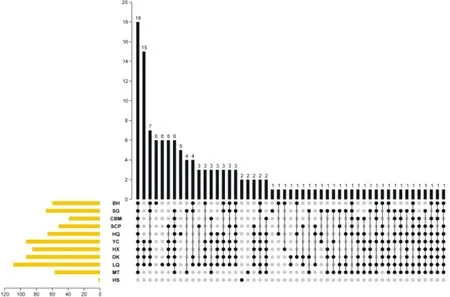
Figure 1 Venn diagram of Ganlu Xiaodu MicroPill target
3.2 Active Ingredients of Traditional Chinese Medicine-Disease Target Network
Intersect with the latest new coronary pneumonia targets in the CTD database to obtain 53 key targets, and build an active ingredient-key target network graph through Cytoscape 3.7.2 ( see Figure 2). The white rectangle in Figure 2 is two or more Chinese medicines All active ingredients are shared. The size of the key target node is based on the corresponding number of effective active ingredients. The larger the number, the larger the node. Get effective active ingredients : 4 mint, 7 fritillaria, 9 cardamom, 1 talc, 16 skullcaps, 5 patchouli, 13 forsythia, 5 mutong, 3 calamus, 11 dried stem, Yinchen 9 . The top 20 chemical components with the largest number of targets (see Table 2).

Figure 2 Network diagram of effective active ingredients of Chinese medicine-key targets
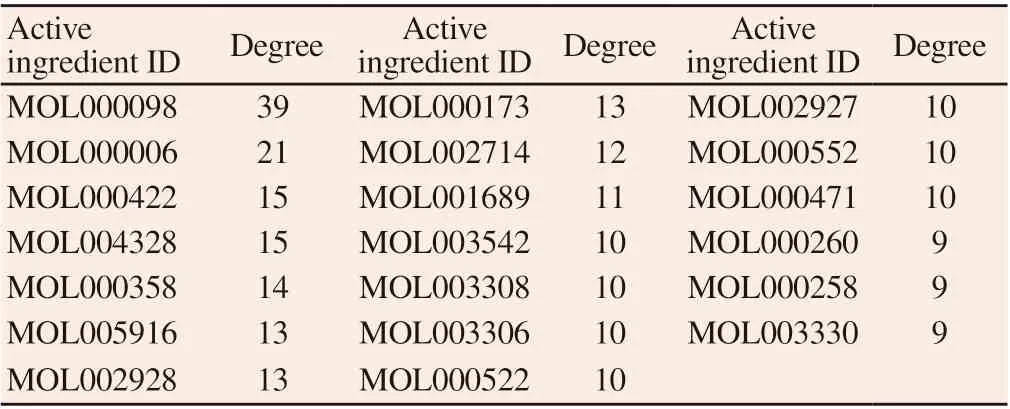
Table 1 Top 20 active ingredients list
3.3 Core target screening
Import the key targets into the String database, and construct the interaction network between the key targets with the condition of confidence 0.4 and "HumanSapiens". And import Cytoscape 3.7.2 software, present protein interaction network diagram (as shown in Figure 3), the greater the value, the larger the node, the darker the color. Screen the relevant targets as the core targets under the condition of degree value 20 (see Table 2).
3.4 GO biological function and KEGG pathway enrichment
53 key targets were run using the ClusterProfiler package of R software, and GO biological functions were enriched to obtain 1298 biological processes (BP), 59 cell compositions (CC), and 62 molecular functions (MF). Finally select the top 10 most significant items to draw BP, CC and MF bubble charts (see Figure 4). Biological processes mainly involve reactions to toxic substances, drugs, nutritional levels, extracellular stimuli, reactive oxygen species, oxidative stress, and external stimuli. The KEGG pathway is enriched to 120 entries, mainly in various viral infection pathways such as hepatitis C, hepatitis B, human cytomegalovirus infection, human T cell leukemia virus I infection, herpes virus, and bacterial infection pathways such as Yersinia and Salmonella. Th17 cell differentiation, C-type lectin receptor and other immunerelated pathways, AGE-RAGE, TNF, HIF-1IL-17, ErbB, NODlike receptors, PI3K-Akt and other related inflammation signal regulation pathways, breast cancer, colorectal cancer, etc. Related cancer pathways. Through GO functional enrichment analysis and KEGG enrichment analysis, it was found that Ganlu Disinfectant Compound has overall anti-virus, anti-infection, anti-tumor, and immune regulation effects. Select the first 20 channels of KEGG to draw a bubble chart (see Figure 5). In the GO and KEGG bubble charts, the X axis represents the percentage, the Y axis represents the item name, the item color represents the P value, and the bubble area represents the enrichment amount. The larger the bubble, the more enriched the entry.
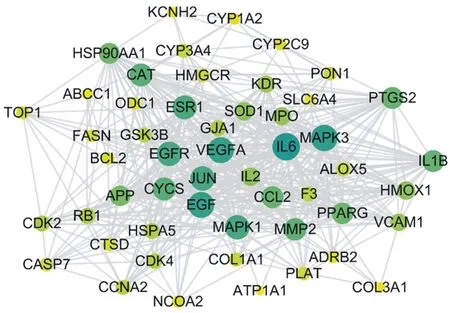
Figure 3 Key target interaction network

Figure 4 GO biological function enrichment analysis diagram
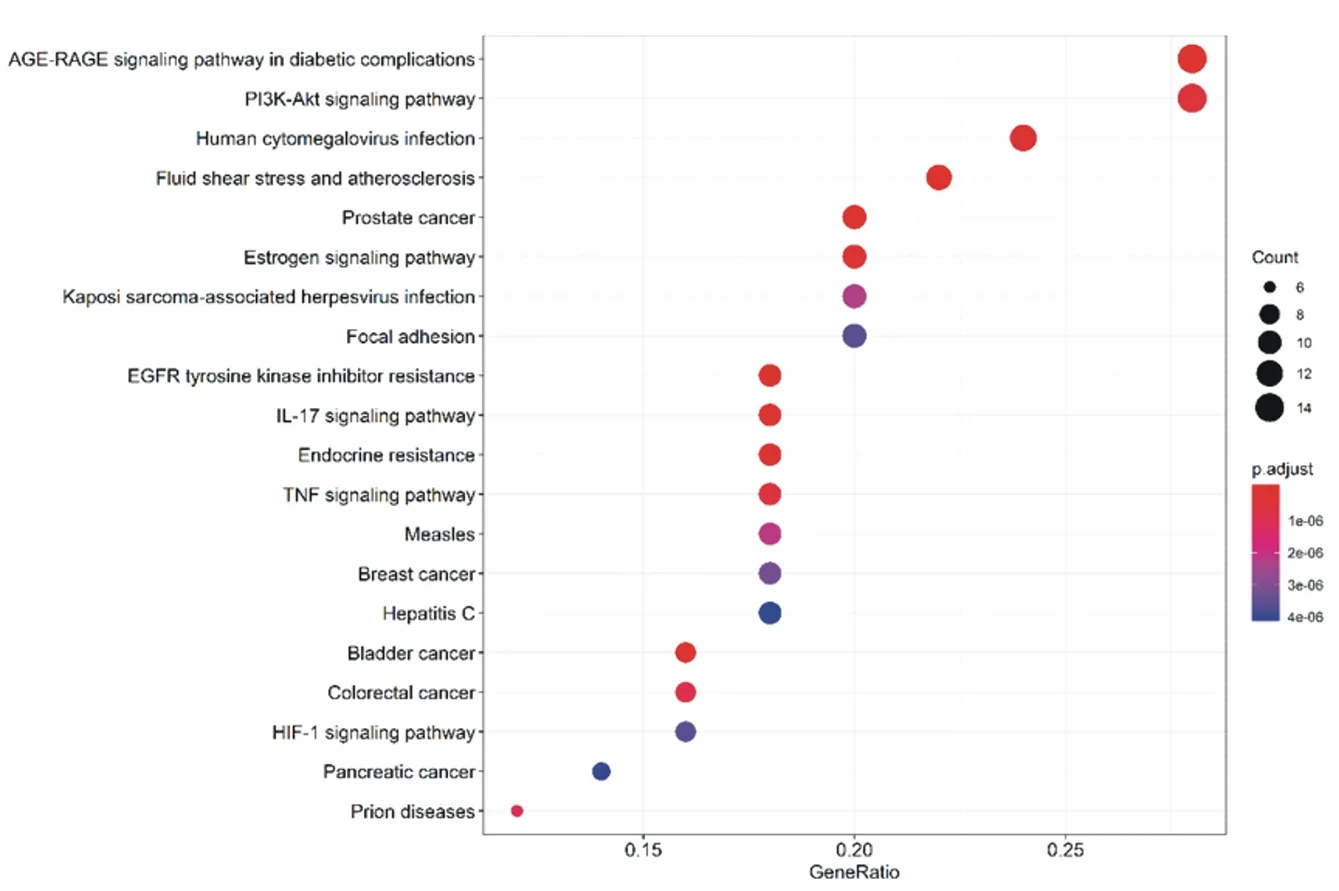
Figure 5 KEGG pathway enrichment analysis diagram
3.5 GXM active ingredient docked with ACE2 and 3CL hydrolase molecules
The active compounds in GXM were searched through TCMSP and BATMAN-TCM databases. The active ingredients are arranged according to the degree value. It is generally believed that the larger the degree value, the more disease targets this component corresponds to, and the stronger the effect. Therefore, the top 20 active compounds (Table 1) and chloroquine (PubchemID: 2719) and ribavirin (PubchemID: 37542) recommended by the national diagnosis and treatment protocol were molecularly docked with ACE2 and 3CLpro, respectively. The smaller the free energy of molecular docking, the greater the affinity between the receptor and the ligand. The results are shown in (Table 3). By comparing the results of 44 molecular docking, it is concluded that the main compound group of GXM has good binding activity with 3CL hydrolase and ACE2, and the binding free energy is less than thatof chloroquine and ribavirin, indicating that GXM has a greater resistance to the new coronavirus potential.

Table 2 Core targets
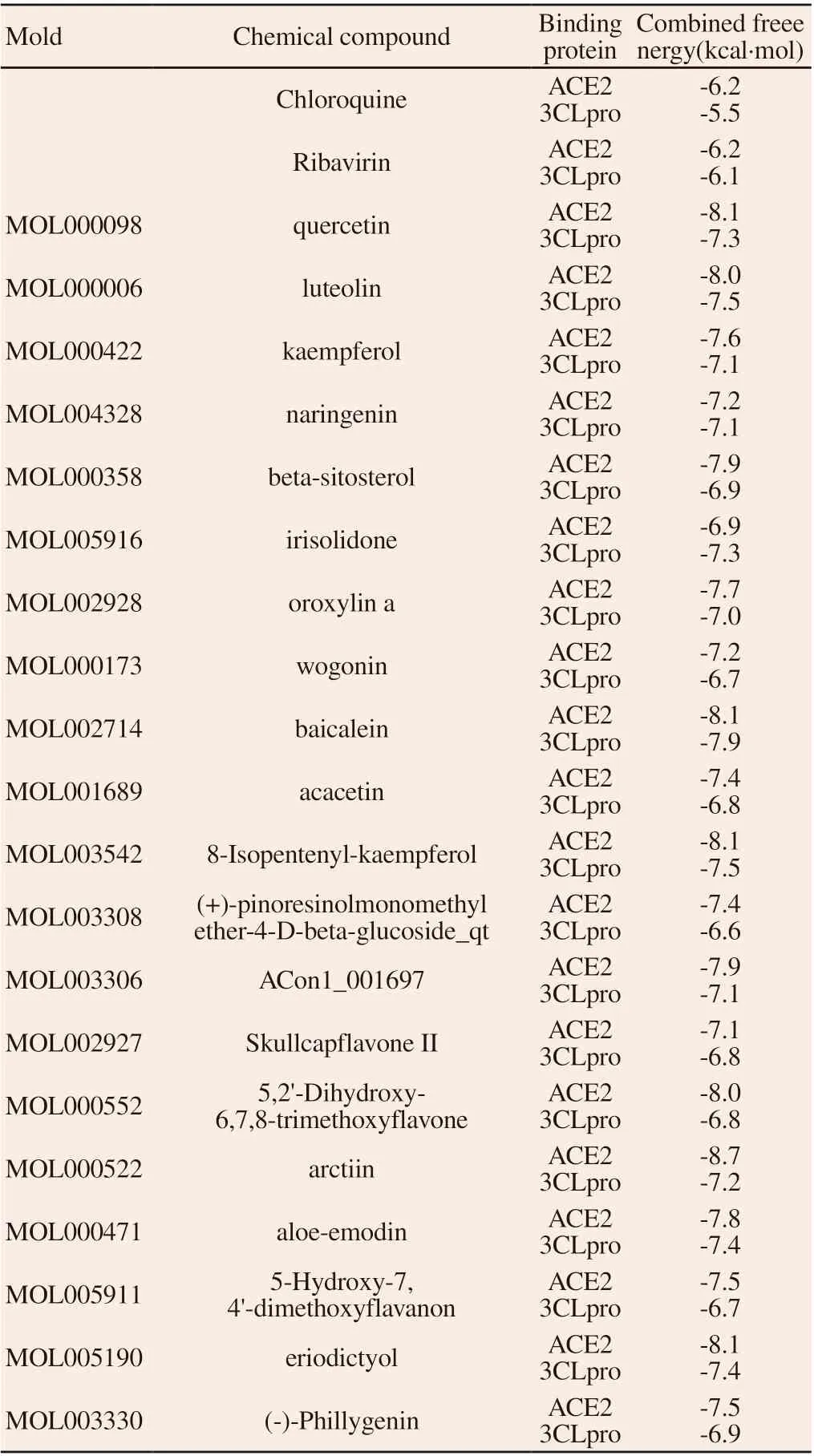
Table 3 Doxane 20 compounds and molecular docking of chloroquine and ribavirin
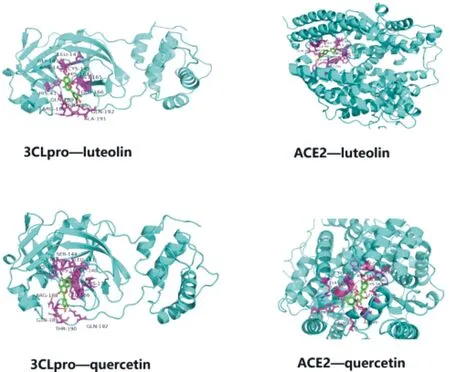
Figure 6 Some molecular docking modes
4. Discussion
The New Coronavirus Pneumonia Diagnosis and Treatment Plan (Trial Version 3) clearly stipulates that the epidemic is in the category of TCM epidemic. The cause of illness is "disease" and the basic pathogenesis is characterized by "wet, heat, poison, and blood stasis." According to the time, the place and the person, the treatment is based on syndrome differentiation. Liu Qingquan, Qi Wensheng, etc. [18] believed that "wet poison" is the core of the pathology of this disease, and the heat of damp poisoning caused stagnation and internal closure. In the early stage of the patient [19], there were many signs of fever, fatigue, chest tightness, epilepsy or nausea, vomiting, loose stools and thick and thick tongue fur. From the dialectical point of view of Weiqiyingxue, fever, fatigue, chest tightness and embolism in patients with new coronary pneumonia, due to the epidemic evil, stagnation of gas, heat and internal heat, steaming with wet, distressed spleen, lost luck Fever and fatigue, fatigue and fatigue, while the gas generator is blocked, the epidemic stops, and the chest is tight and wheezing. At this time, Ganlu disinfection Dan is used to clear the heat and detoxify, dampen the turbidity, adjust the Qi machine, and drive out evil spirits. In the classical prescription, peppermint and forsythia suspense the surface, clear away heat and detoxify; shoot dry, chuanbei mother purging lung to relieve cough, Huangqin clears lung fire; talc, Mutong, Yinchen clear dampness and heat, make dampness come out from urination, give disease pathogen a way out; patchouli, cardamom, Acorus calamus fragrance dampness, invigorate spleen and middle, make qi smooth and wet, reach upper source clear and flow from clean, lower orifices pass and wet out. Set heat-clearing and detoxification, aromatherapy dampness and turbidity in one. From the Qing Dynasty to the present, it has been widely used in clinic, and it has a good effect on a variety of acute infectious diseases and infectious diseases [18].
Chen Ling et al [21] through the rule of traditional Chinese medicine treatment of 875 cases of COVID-19 treated with traditional Chinese medicine, it was found that the core prescription for the treatment of COVID-19 was dehumidifying agent Mannan disinfectant Dan. Clinical observation and study [22] found that 131 patients with new crown pneumonia were not classified by traditional Chinese medicine, all of them were treated with Mannan Xiaodan decoction, the cure rate was 100%, and the adverse reaction was 0. This shows that GXM is generally applicable, safe and effective in the treatment of patients with COVID-19. Modern clinical and experimental studies have found that GXM can inhibit virus replication, regulate liver injury, regulate immunity and positively regulate inflammatory factors.
Through the prediction of drug target active components, it was found that luteolin, quercetin, kaempferol and other compounds were the first active components. Modern pharmacological studies have found that [26] luteolin can inhibit the expression of COX-2 and the production of PGE2, and then down-regulate the expression of inflammatory factors such as IL-6 and TNF- α, inhibit the development of pulmonary inflammation and promote prognosis. Quercetin belongs to flavonoids. It has been found that [27] quercetin may reduce cardiomyocyte injury, antiviral, antioxidant stress and apoptosis by activating PI3K/AKT pathway. Quercetin [28] can also inhibit the expression of Caspase3 protein, down-regulate the expression of TLR7, reduce the production of inflammatory factors and chemokines, improve pulmonary inflammation, inhibit H1N1 virus infection, and play an antiviral role. Kaempferol [29] can inhibit the expression of pro-inflammatory cytokines NF- κ B, IL-1 β, iNOS and TNF- α in lung tissue, and also inhibit the imbalance of oxidation-antioxidation balance caused by acute lung injury. Most of the active components of GMX are flavonoids, which confirms the antiviral effect of GMX from the material basis. In this study, through molecular docking study, it was found that the affinity of the first 20 active compounds to ACE2 and 3CLpro was higher than that of chloroquine and ribavirin, which indicated that the compatibility of GMX was reasonable, and it also had a certain scientific significance for the screening and research and development of antiviral drugs.
Through the drug disease target network map, it is found that the targets of GXM in the treatment of COVID-19 are mainly focused on the core targets such as MAPK3, IL6, VEGFA, EGFR, MAPK1 and so on, and most of them are related to inflammatory reaction. Among them, MAPK1 and MAPK3 belong to the [30] MAPK family, which can induce pro-inflammatory response, play a key role in the production, differentiation and proliferation of inflammatory cells, and participate in pulmonary inflammation and tissue injury. The increase of VEGFA [31] level may be related to the regression of pulmonary inflammation. EGFR [32] is a transmembrane protein related to the epidermal growth factor family, which can inhibit airway inflammation by inhibiting the activity of tyrosine kinase. GO and KEGG enrichment analysis showed that signal pathways were mainly concentrated in viral infection, bacterial infection, inflammatory pathways, immune pathways and cancer-related pathways, which may play a therapeutic role through the activation of Akt pathways by TNF, HIF-1, IL-17, ErbB and PI3K. MAPK1, PTGS2 and PI3K-Akt signaling pathways play a key role in affecting RNA virus replication and in the treatment of pneumonia. Among them, IL2 and IL6 can regulate the differentiation of Th17 cells, while Th17 cells are related to inflammatory diseases and immune mechanisms [34-35]. C-type lectin receptor (CLRs) is an important pattern recognition receptor. High expression of (DCs), in dendritic cells to activate CLRs expressed on DCs can significantly enhance the immune system and play an important role in viral infection and antifungal immunity [36-37]. Therefore, it can be speculated that GXM may play a role in the treatment of new crown pneumonia by regulating virus, inflammation and immune pathway, so as to prevent patients from mild to severe, prevent disease and truncate torsion.
To sum up, GXM not only aims at the two key targets of ACE2 and 3CLpro, but also regulates and interferes SARS-CoV-2 infection through other targets such as anti-virus, anti-inflammation and regulating immunity, which fully reflects the multiplicity and universal adaptability of the treatment mechanism of traditional Chinese medicine. This study provides a theoretical basis for the treatment of COVID-19 with GXM, and preliminarily screened the effective active ingredients and related targets, which is helpful to speed up the development of natural antiviral drugs. At the same time, it also shows that Ganlu Xiaodu MicroPill has the advantages of multi-components, multi-targets and multi-pathways.
Acknowledge
Thank Chief physician Chen Xinju and Dr. Chen Xiaoqi for their guidance in topic selection and writing, and Dr. Zhao Qing, Sister Liang Jiaqi and Sister Xie Kang for their guidance in the application of network pharmacology and molecular docking technology. )
杂志排行
Journal of Hainan Medical College的其它文章
- Toxicity effects of paclitaxel exposure on Caenorhabditis elegans
- The relationship between cellular immune level and diabetic foot in type 2 diabetic patients
- Clinical significance of TnI, hs-CRP and NT-proBNP in the diagnosis of myocardial damage in uremia patients
- Comparative study of 99Tc-MDP and zoledronic acid in the treatment of osteoporosis
- Clinical study on the treatment of bronchiectasis in remission period by embedding thread combined with Jianpi Qushi Huayu plaster
- Research on the rules of Professor Dai Xiaohua's medication for coronary heart disease and chronic heart failure based on data mining
